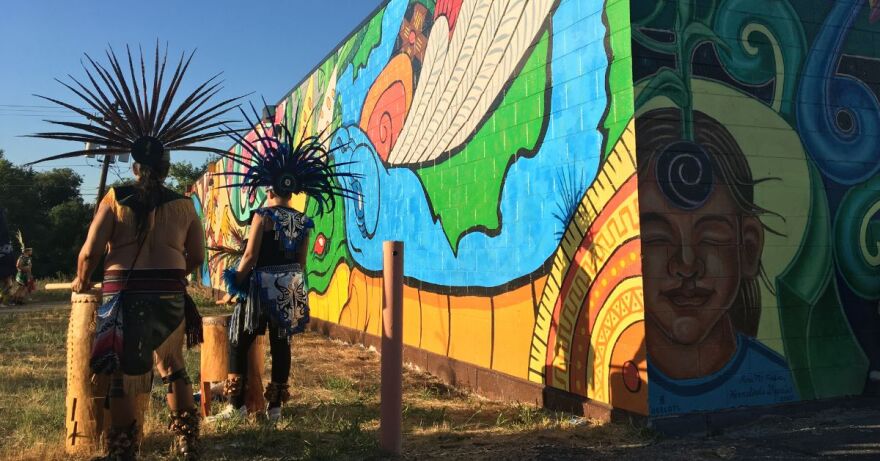In 2022 the National Trust for Historic Preservation included several Chicano murals in Colorado in its annual report of “America’s 11 Most Endangered Historic Places.”
The Chicano/Chicana/Chicanx Murals of Colorado Project is working to preserve these murals in recognition of their critical community and cultural significance.
On a Friday evening in late July, dancers and musicians from the Grupo Tlaloc Danza Azteca gathered in the Sun Valley Neighborhood of Denver, near the intersection of West 8th Street and Federal Boulevard.
They were there to celebrate the restoration of community murals that had been erased from public view.
At the helm of the effort is Lucha Martinez de Luna, Director of the Chicano/Chicana/Chicanx Murals of Colorado Project.
She's also the curator of Latino History and Culture at History Colorado.
Shannon Young: While these are separate projects, there is an intersection between Latino history within the state of Colorado and these Chicano, Chicana, Chicanx murals in Denver. What is that intersection, and how did you end up at the corner of it?
Lucha Martinez de Luna: That's an interesting story. The reality is I'm actually an archaeologist and I'm director of an archaeological site in Mexico.
And really, the story begins when I'm younger, because I was fortunate enough to grow up surrounded by art.
My father was the pioneer of the mural movement here in Colorado, and my whole life I was around murals, the other artists painting the murals, collaborations with my father, and other muralists, and I really felt like they were a part of my life, these murals.
And so when I started this archeological project that I'm currently working on, I would be going back and forth to Chiapas, Mexico, and I would be gone for about a month or two, and then I'd come back.
And, you know, when you step away from your city for a little while, or your home for a little while, it's amazing what you, like, you appreciate your home a lot more, but then you also notice when a city is being gentrified, and displacement is happening at a very fast rate, you notice things that I think you take for granted were there before.
And that's what was starting to happen.
It's like, 'wait, I turn a corner, it's like, wasn't there a building there before?
Wasn't there an older house there before, and wasn't there a mural there?'
So I just couldn't believe how fast things were changing, like circa 2011, 2012, how quickly things were happening in the city.
So I started really getting worried about the murals.
I was like, if they're being erased, first of all, is there any conversations happening about the erasure of these murals?
And then second of all, do we have archives of these murals that are being erased?
So I started attending preservation meetings, and one of the first questions I asked them at these meetings, because they would do community meetings, talking about buildings and the other structures, and it's like, 'well, what are you doing about murals?'
And, and I said, 'why don't we hear about the preservation of murals?'
And the reality is in Denver, I found out, and I believe in Colorado, that murals are considered paint on a wall, so they don't even think of them as a work of art.
They don't think about their value, their cultural value, or their historic value.
So what do you do when you're trying to protect something that is considered paint on a wall?
If I told anybody that in Mexico, they would just like burst out laughing, it's like, how could you possibly call a mural just paint on a wall?
Shannon Young: And the Chicano, Chicana, Chicanx mural project has gotten a lot of what, like 40 murals in the Denver area on a register or at least registered as endangered?
What was that process like, and how many more murals on that list have yet to be restored?
Lucha Martinez de Luna: So, 2021, in the fall, I submitted an application with the support of History Colorado, Historic Denver, and the City of Denver.
And CMCP, the Chicano Murals of Colorado Project, nominated the Chicano murals in Colorado, so, it's not just Denver, it's in all of Colorado, to be on the 11 most endangered places, and, they were selected.
So, what that meant is, for the very first time, murals have been recognized on this list.
And they were Chicano murals from Colorado, and we're calculating that there's approximately 40 murals in the state that potentially could be restored, that are historic or legacy murals.
So the plan is to keep moving along and doing this, but it is going to be very challenging because we always need to take into consideration who owns the building and if they're willing to work with us because we can't just tell the building owner, 'hey, you need to protect this mural. We got to preserve it.'
They've got to protect the integrity of it for 50, 100 years from now.
They have to be on board with wanting to do that.
So that building awareness is really key to this.
This story was shared via Rocky Mountain Community Radio, a network of public media stations in Colorado, Wyoming, Utah and New Mexico including Aspen Public Radio.


